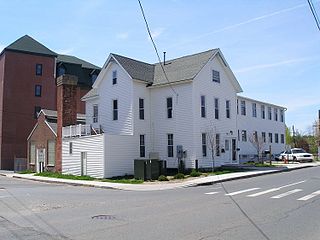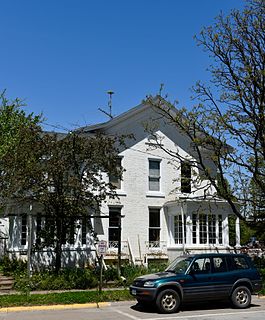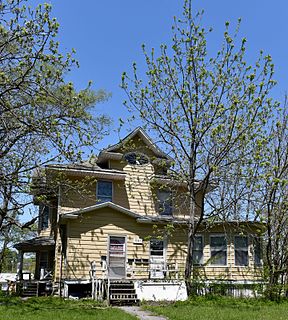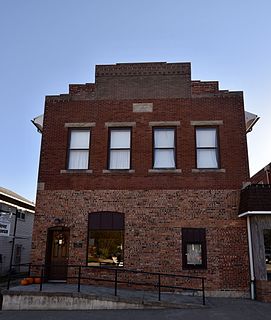
The Graybar Electric Company Building is located at 55 West Canfield Street in Midtown Detroit, Michigan. This warehouse building was rented to the Graybar Electric Company from 1926 into the 1940s. It was listed on the National Register of Historic Places in 1997.

The Ball and Roller Bearing Company, also known as American Family Crafts and the Joseph Nutt House and Machine Shop, is a historic industrial complex at 20-22 Maple Avenue in Danbury, Connecticut. Developed mainly in the early 20th century, the factory is most notable as the location where Lewis Heim invented the modern grinding machine, which revolutionized the manufacture of machine parts. The complex was listed on the National Register of Historic Places on August 25, 1989. It now houses a church and social service agencies.

The R. Bruce and May W. Louden House is an historic building located in Fairfield, Iowa, United States. Original construction is in a colonial revival style and the interior was remodeled in an art deco style in 1928. Louden sold the property in 1948, and it was broken into apartments in the 1960s. The house was built in 1905 and was the residence of R. Bruce and May W. Louden until 1948.

The R. B. and Lizzie L. Louden House, also known as the William and Susan F. Elliott House and the John and Gladdy Ball House, is a historic residence located in Fairfield, Iowa, United States. The single family dwelling was built in 1871 for William and Susan Elliott. The house's historical significance derives from its association with R. B. Louden, who served as the president of the Louden Machinery Company from 1899 through 1939 and his residence here. He and his wife Lizzie substantially remodeled the house in 1900 and 1929, which gives it its eclectic appearance. The latter addition includes two enclosed porches and a sleeping porch designed by Ottumwa, Iowa architect George M. Kerns. The historic designation includes the 2½-story brick house and the 2-story, brick, double garage in the back. It was listed on the National Register of Historic Places in 1999.

The Louden Machinery Company was an American engineering, manufacturing and design company based in Fairfield, Iowa. Founded by William Louden, the company in its early years manufactured and sold the patented hay carrier that he invented in 1867. The company later expanded into a wide variety of farm equipment and, in 1906, began an Architecture Department that reportedly designed more than 25,000 barns from 1906 to 1939. During World War I, Louden's monorail equipment carrier began to be applied to industrial and military applications. By the 1920s, much of the company's revenues were derived from industrial applications of its monorail equipment carriers.
Midway Stock Farm Barn was a historic building located north of Keosauqua, Iowa, United States. The barn was built by William A. Barker around 1880. It gained historical significance when his son Webb installed equipment made by the Louden Machinery Company of Fairfield, Iowa. By doing so he converted the facility from one that raised livestock to a dairy operation. Around 1918 Barker built an addition onto the south side of the barn and installed a litter carrier with tracks and switches on the ground floor, a hay carrier with a steel track and grapple hook hay fork also on the main floor, and a metal aerator on the roof. It was one of a few local operations that still had the Louden equipment in place.

The Fred and Rosa Fulton Barn is a historic building located north of Selma, Iowa, United States in rural Jefferson County. The barn was built by Rosa from plans prepared by the Louden Machinery Company of Fairfield, Iowa. It is a good example of the company's Gothic laminated roof design. The barn also includes other Louden-manufactured devices, including "Master-Made" ventilator windows, metal roof aerators, hay carrier and fork, and door tracks and trolleys. This equipment is original to the barn's construction in 1947. Built for a dairy operation, the structure has subsequently been used for general farm purposes. The barn was listed on the National Register of Historic Places in 1999.
The August and Vera Luedtke Barn is a historic building located north of Fairfield, Iowa, United States in rural Jefferson County. The barn was built by Luedtke from plans prepared by the Louden Machinery Company of Fairfield. He had previously built other barns using the same company's designs in the area. This barn features a gambrel roof, concrete walls, and eleven intact Louden dairy stanchions and a hay carrier system that are original to the building's construction in 1947. Built for a dairy operation, the structure has subsequently been used for storage. The barn was listed on the National Register of Historic Places in 1999.

The Burnett–Montgomery House is a historic house located at 605 North Third Street in Fairfield, Iowa.

US Senator James F. Wilson House, also known as the Hamilton House and the Fulton House, is a historic residence located in Fairfield, Iowa, United States. This house was built for attorney William L. Hamilton in 1854. Its notoriety is derived from the residency of James F. Wilson, who lived here from 1863 to 1895.

The R.R. and Antoinette Louden House, also known as the Thomas A. and Dorothy C. Louden House, is a historic residence located in Fairfield, Iowa, United States. R.R. (Roy) Louden was the highly successful manager of the Louden Machinery Company advertising department in the 1920s, and he served as the corporation's secretary from 1931 until his death in 1951. He and his wife Antoinette had this house built in 1925. He lived here until his death in 1951. Their son Thomas and his wife Dorothy lived in the house after his parents. Thomas became general legal counsel for the company in the 1940s. The house is 2½-story, brick Colonial Revival with a side gable roof. It features a wall chimney on the east elevation, a single-story solarium, and a single-story porch on the main facade. An addition was added to the rear of the house in 1956. A two-car attached garage was built onto the addition in the 1980s. The house was listed on the National Register of Historic Places in 1999.

The William and Mary Jane Louden House is a historic residence located in Fairfield, Iowa, United States. It historical significance is derived from its association with William Louden, a co-founder of Louden Machinery Company with his brother R.B. Previously, he secured his first two patents by 1867: one was for hay-stacking, and another was for hay-carrying. He would go on to obtain over 100 more patents. Being the inventive genius of the firm, William brought it to a national reputation in barn construction and farm equipment. The house is a 2½-story, frame, single family dwelling. It was built for the Louden's by C.E. Ward from 1896 to 1897 in the Queen Anne style. The house was listed on the National Register of Historic Places in 1999.

The Louden Monorail System in the Auto Repair Shop, also known as McGuire Motor Company and Crandall's Electric Service, is a historic structure located in Fairfield, Iowa, United States. The monorail system is located in a former auto repair shop along an alley between East Broadway Avenue and East Briggs Avenue. It is the rear, single-story, portion of the building at 117 E. Broadway Ave where the system is located. The storefront portion of the building, also historically associated with the automobile industry, is a two-story brick building built on a stone foundation. The east side of the central business district in Fairfield had become the center for automobile related businesses by the 1920s. Harley Carter bought this building in 1920, and had the monorail system, manufactured by the Louden Machinery Company, installed about 1922. The overhead material handling system is permanently attached to the east wall of the shop. It allowed the mechanics to more easily move the heavy engines and other parts to and from vehicles. The structure was listed on the National Register of Historic Places in 1999.

The Iowa Malleable Iron Company was a historic industrial complex located in Fairfield, Iowa, United States. At one time the historic designation included nine buildings, most of them have been torn down. The remaining building was the two-story office building for the factory that was constructed in 1924. Most of the complex was built in 1904 north of the Chicago, Burlington and Quincy Railroad tracks. The company produced malleable iron castings for agricultural implement manufacturers, including Fairfield's Louden Machinery Company. For the most part it was established by the officers of the Louden Company, and it is thought to be the first foundry of its kind between the Mississippi River and Pueblo, Colorado. The two companies maintained a close association throughout their histories. The complex was listed on the National Register of Historic Places in 1999.

Wildwood Park Historic District is a nationally recognized historic district located in Charles City, Iowa, United States. It was listed on the National Register of Historic Places in 1998. At the time of its nomination it consisted of 26 resources, which included three contributing buildings, one contributing site, nine contributing structures, one contributing object, seven non-contributing buildings, and five non-contributing structures.

The Dubuque Casket Company is a historic building located in Dubuque, Iowa, United States. The city was a leading national market in the production of caskets towards the end of the 19th century. This location had been the site of a casket manufacturing plant from 1877 to 1987. The Dubuque Furniture and Burial Case Company was the first firm in Dubuque and the first to locate here. The building was largely destroyed by fire in 1883 and the company was forced out of business. The Dubuque Casket Company was incorporated in 1893 and acquired this property. They started construction of the first part of this building the same year. The four-story brick Neoclassical building was one of the largest manufacturing facilities in Dubuque. The machine and equipment room was located on the first floor, they manufactured fine cloth covered caskets on the second floor, they manufactured undertaker's dry goods on the third floor, and the fourth floor was used for storage. The first addition, now known as the center section was begun in 1903, and another expansion that also unified the main facade was begun in 1911. Two other Dubuque casket manufacturers, Iowa Coffin Company and the Hawkeye Casket Company, were out of business by 1924.

Bandshell Park, also known as City Park and Music Pavilion, is located in Ames, Iowa, United States. It is a nationally recognized historic district that was listed on the National Register of Historic Places in 1999. At the time of its nomination it consisted of six resources, which included one contributing building, one contributing site, two contributing structures, one contributing object, and one non-contributing object. The park, located to the east of the central business district, was gift to the city in 1884 from the C&NW Land Company. The full city block was the first park established in Ames.

The Peterson Manufacturing Building, also known as the New London Cooperative Creamery, is a historic building located in New London, Iowa, United States. The first floor of this building was constructed in 1908 by John Edgar Peterson so he could expand his glove and mitten factory. Peterson was also instrumental in the establishing the First National Bank in New London and served as its president, the Henry County Telephone Company, the New London Improvement Company, and the New London Land Company. The second floor of this building was completed in 1909 by the local Masonic lodge. Peterson died in 1917 and glove and mitten factory closed briefly before it was reopened by the Fairfield Glove and Mitten Factory. In 1928 that factory closed and the building housed a creamery until 1968. After being used as a warehouse it was donated to the Dover Historical Society for a historical museum. The building was listed on the National Register of Historic Places in 1997.

The Monroe Elementary School Historic District is a nationally recognized historic district located in Cedar Rapids, Iowa, United States. It was listed on the National Register of Historic Places in 2015. At the time of its nomination it consisted of 10 resources, which included one contributing building, one contributing site, three contributing objects, two non-contributing buildings, and three non-contributing objects. The school building was completed in 1961 in a neighborhood of small ranch-style houses from the same era. Designed by the Cedar Rapids architectural firm of Brown & Healey, it was one of seven schools built as a result of a bond referendum in 1959. It was necessitated by a roughly 70% increase in enrollment between 1950 and 1960. The single story, brick building features long and wide corridors, low ceiling heights, extensive use of glazing, exposed trusses, and deep overhangs. The building retains historical integrity, while the other school buildings built at this time in Cedar Rapids do not. Two basketball hoops and a fire engine-shaped piece of playground equipment are the contributing objects. The non-contributing buildings are two temporary classrooms, three pieces of playground equipment are the non-contributing objects. It ceased being a school building in 2011.
Fred Maytag Park is a public park located in Newton, Iowa, United States. It was listed as a historic district on the National Register of Historic Places in 2010. At the time of its nomination it contained 39 resources, which included seven contributing buildings, nine contributing sites, eight contributing structures, four contributing objects, four non-contributing buildings, two non-contributing sites, three non-contributing structures, and two non-contributing objects. The park was a gift from F.L. Maytag, founder of the Maytag Company, to the people of Newton. It is significant as an example of a privately funded public park during the Great Depression. The 40-acre (16 ha) partial of land was acquired by Maytag in 1935. It had previously served as the fairgrounds owned by the Jasper County Agricultural Society. He made an agreement with the city council that the park would be privately owned and operated, but open for public use. The city was required to provide water and electricity. It remained a privately owned park until 1977 when it was conveyed to the city.




















